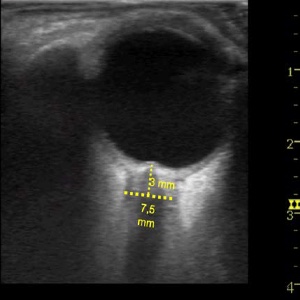Accuracy of bedside sonographic measurement of optic nerve sheath diameter for intracranial hypertension diagnosis in the emergency department

Accepted: 8 May 2023
All claims expressed in this article are solely those of the authors and do not necessarily represent those of their affiliated organizations, or those of the publisher, the editors and the reviewers. Any product that may be evaluated in this article or claim that may be made by its manufacturer is not guaranteed or endorsed by the publisher.
Authors
Ultrasound measurement of the optic nerve sheath diameter (US ONSD) has been proposed as a method to diagnose elevated intracranial pressure (EICP), but the optimal threshold is unclear. The aim of this study was to assess the accuracy of US ONSD, as compared to head computed tomography (CT), in detecting EICP of both traumatic and non-traumatic origin. We conducted a prospective, cross-sectional, multicenter study. Patients presenting to the emergency department with a suspect of traumatic or non-traumatic brain injury, referred for an urgent head CT, underwent US ONSD measurement. A US ONSD ≥5.5 mm was considered positive. Sensitivity, specificity, positive and negative predictive values, and positive and negative likelihood ratios were calculated for three ONSD cut-offs: 5.5 (primary outcome), 5.0, and 6.0 mm. A receiver operating characteristic (ROC) curve was also generated and the area under the ROC curve calculated. Ninetynine patients were enrolled. The CT was positive in 15% of cases and the US ONSD was positive in all of these, achieving a sensitivity of 100% [95% confidence interval (CI) 78; 100] and a negative predictive value of 100% (95% CI 79; 100). The CT was negative in 85% of cases, while the US ONSD was positive in 69% of these, achieving a specificity of 19% (95% CI 11; 29) and a positive predictive value of 18% (95% CI 11; 28). The US ONSD, with a 5.5 mm cut-off, might safely be used to rule out EICP in patients with traumatic and non-traumatic brain injury in the ED. In limited-resources contexts, a negative US ONSD could allow emergency physicians to rule out EICP in low-risk patients, deferring the head CT.
How to Cite

This work is licensed under a Creative Commons Attribution-NonCommercial 4.0 International License.
PAGEPress has chosen to apply the Creative Commons Attribution NonCommercial 4.0 International License (CC BY-NC 4.0) to all manuscripts to be published.

 https://doi.org/10.4081/ecj.2023.11333
https://doi.org/10.4081/ecj.2023.11333








